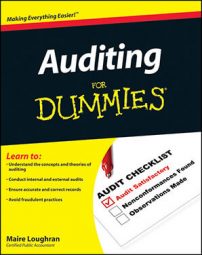The goal of a financial statement audit is for you (the auditor) to form an opinion regarding whether those statements are or aren’t free from error. To do so, you use your best professional judgment when assessing your client’s information and assertions. Although every company is different, and each audit you work on will vary, you can follow some common procedures. Here are a few of the tasks you want to accomplish while conducting your audits.
Evaluate relevance and reliability
You can’t issue an audit opinion unless you have sufficient, competent evidential matter. Relevance and reliability are two hallmarks of good evidence:
Relevance means the evidence directly relates to the facts you’re trying to substantiate. For example, valuation of a checking account in U.S. dollars isn’t relevant, because the worth of a dollar is so straightforward. However, valuation is critical in determining what the correct ending inventory figure should be.
Reliability means you can depend on the evidence to steer you in the right direction. For example, evidence is more reliable if it’s in written rather than oral form, or if a knowledgeable independent source from outside your audit client substantiates something the client told you.
Test management assertions
Your client’s management assertions must be presented on the financial statements using generally accepted accounting principles, or GAAP. Because you can’t prepare the financial0statements under audit, you need to know GAAP. It’s your responsibility to realize when GAAP aren’t being uniformly applied and to inform the client of that fact so it can correct the error.
To help you get your feet wet, here are generic descriptions for various management assertions:
Occurrence: The transactions management shows on the financial statements actually took place. For example, if the client records a sale of $5,000, you make sure a delivery of a good or service to a real-live customer actually happened.
Completeness: Whatever event took place is recorded in its entirety. For example, the $5,000 sale is booked as revenue for the whole $5,000 and not for a lesser amount (because management doesn’t want to pay taxes on the entire sale amount).
Classification: Management takes the transaction to the correct account. For example, the company records the $5,000 sale as revenue and not a loan from a shareholder.
Cutoff: Transactions are on the financial statements for the correct period. For example, if the audit client has a calendar year-end of December 31, only sales taking place prior to close of business on December 31 are recorded on the current financial statements.
Rights and obligations: The client owns or holds the rights to assets and is indeed responsible for the liabilities shown on the balance sheet. Examples of assets are cars, buildings, computers, and machinery. Examples of liabilities are accounts payables and loans taken out to buy the assets.
Issue an opinion
Well, after all the hard work you do during the auditing process, your firm is the expert that gives its professional opinion about how much reliance users can place on the audit topic at hand.

